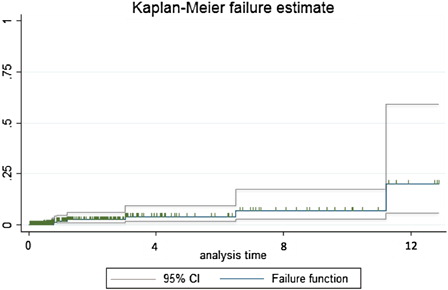Figures & data
Figure 1. Cumulative probability along time (in years) of developing a subsequent malignant neoplasm in the group of 416 patients allografted using the Mexican reduced intensity conditioning method. The cumulative failure rate, and its 95% Greenwood's confidence intervals is shown. For this purpose, subjects dead or lost to follow up were taken as censored (ticks). SMN rates (95% CI) at selected intervals were as follow: one year post-graft: 1.9% (0.7–4.9%), 5-years: 3.8% (1.6–9.2%), 10-years: 6.8% (2.6–17.7%), and 13-years post-graft: 20.2% (5.5–59.2%).

Table 1. Salient features of the eight patients with a secondary malignant neoplasia identified in a group of 416 patients allografted using the Mexican reduced intensity conditioning method
Table 2. Cumulative probability of developing a secondary malignant neoplasm, either a post-transplantation lymphoproliferative disorder or a solid tumor, in patients given allogeneic hematopoietic stem cell transplants
